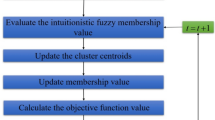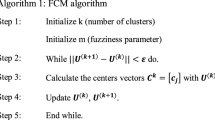Abstract
Clustering is a process of partitioning similar data into groups. For this, number of clustering algorithms have been proposed in literature. Some of them can also be used for the generation of Fuzzy Models. In this work, Sugeno fuzzy models being generated by Subtractive and FCM clustering have been discussed. Experiments have been performed on real datasets to compare the Subtractive and FCM clustering. Further, the effect of increase in the radius size is analyzed in Subtractive clustering. The average absolute error and root mean square error is also found out when using FCM clustering and Subtractive clustering with different values of radius.



Similar content being viewed by others
References
Hammouda K, Karray F (2000) A comparative study of data clustering techniques. Fakhreddine Karray University of Waterloo, Ontario
Zadeh LA (1965) Fuzzy sets. Inf Control 8(3):338–353
Polo J (2001) Development and testing of a number of MATLAB based fuzzy system applications. http://deeea.urv.cat/public/PROPOSTES/pub/pdf/120pub.pdf. Accessed 12 Aug 2016
Kim K, Kim YK, Kim E, Park M (2004) A new TSK fuzzy modeling approach. In: Proceedings of 2004 IEEE International Conference on Fuzzy Systems, 2004, IEEE, vol 2, pp 773–776
Siler W, Buckley JJ (2005) Fuzzy expert systems and fuzzy reasoning. Wiley, Hoboken, New Jersey
Mendel JM (1995) Fuzzy logic systems for engineering: a tutorial. Proc IEEE 83(3):345–377
Jang JSR, Sun CT, Mizutani E (1997) Neuro-fuzzy and soft computing; a computational approach to learning and machine intelligence. Prentice Hall, Upper Saddle River, NJ
Zimmermann HJ (1994) Fuzzy set theory-and its applications. Kluwer Academic Publishers
Polat K (2016) Intelligent recognition of diabetes disease via FCM based attribute weighting. World Acad Sci Eng Technol Int J Comput Electr Autom Control Inform Eng 10(4):676–680
Bataineh KM, Naji M, Saqer M (2011) A comparison study between various fuzzy clustering algorithms. Jordan J Mech Ind Eng 5(4):335–343
Nayak J, Naik B, Behera HS (2015) Fuzzy C-Means (FCM) clustering algorithm: a decade review from 2000 to 2014. Comput Intell Data Min 2:133–149 Springer India
Ghosh S, Dubey SK (2013) Comparative analysis of k-means and fuzzy C-means algorithms. IJACSA Int J Adv Comput Sci Appl 4(4):35–39
Yazdani-Chamzini A, Razani M, Yakhchali SH, Zavadskas EK, Turskis Z (2013) Developing a fuzzy model based on subtractive clustering for road header performance prediction. Autom Constr 35:111–120
Chiu SL (1994) Fuzzy model identification based on cluster estimation. J Intell Fuzzy Syst 2(3):267–278
Author information
Authors and Affiliations
Corresponding author
Rights and permissions
About this article
Cite this article
Goyal, L.M., Mittal, M. & Sethi, J.K. Fuzzy model generation using Subtractive and Fuzzy C-Means clustering. CSIT 4, 129–133 (2016). https://doi.org/10.1007/s40012-016-0090-3
Published:
Issue Date:
DOI: https://doi.org/10.1007/s40012-016-0090-3




